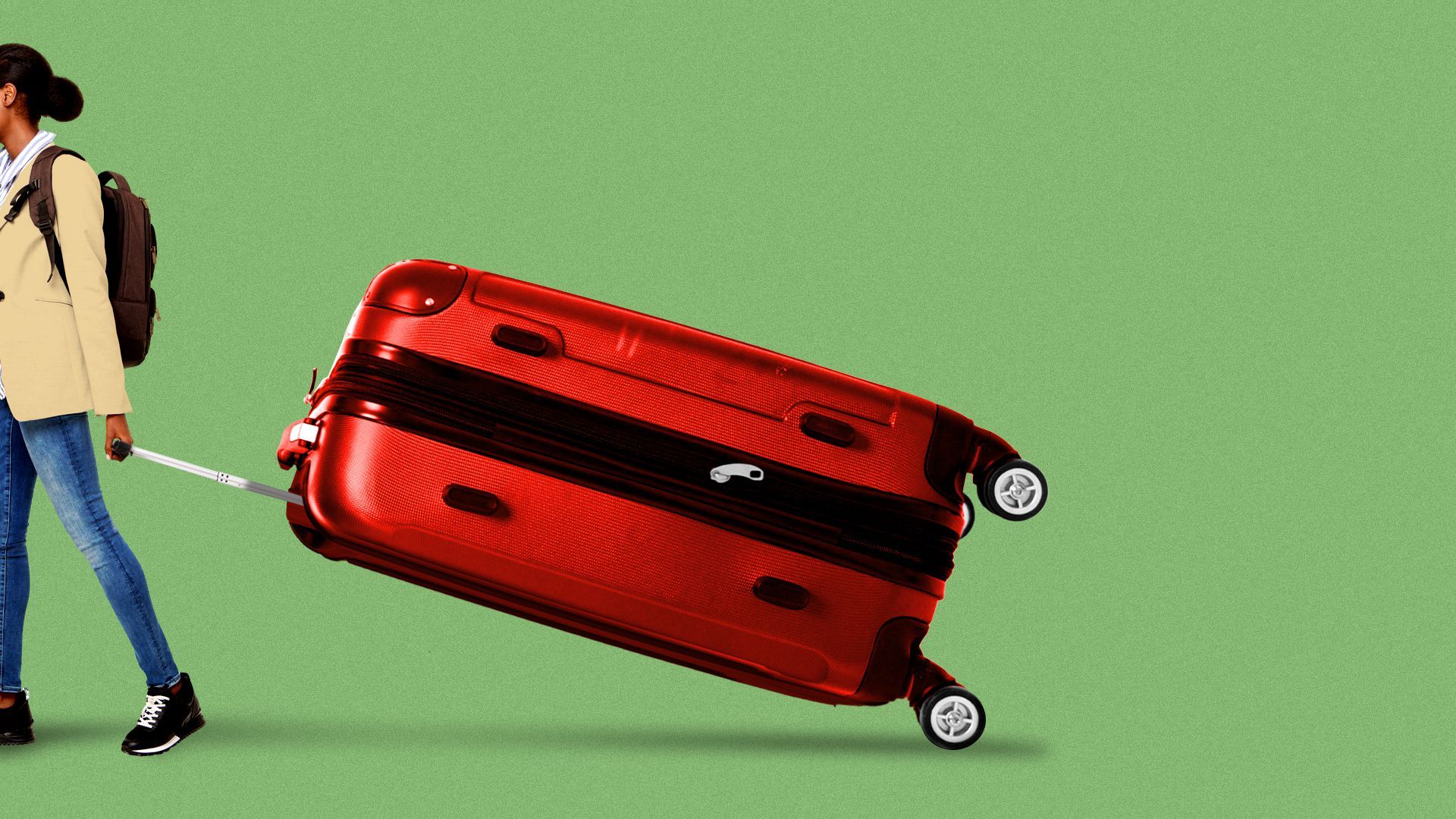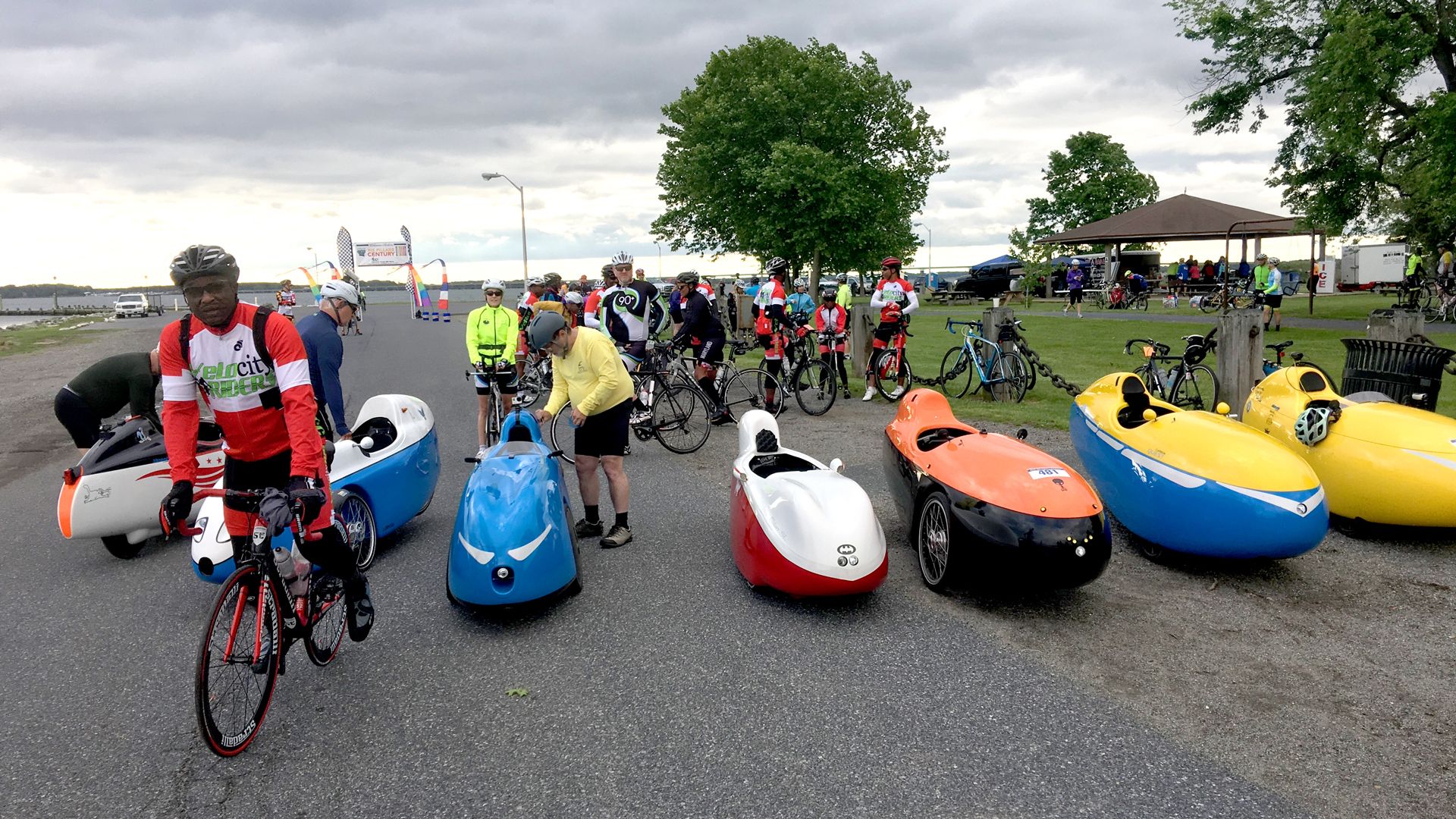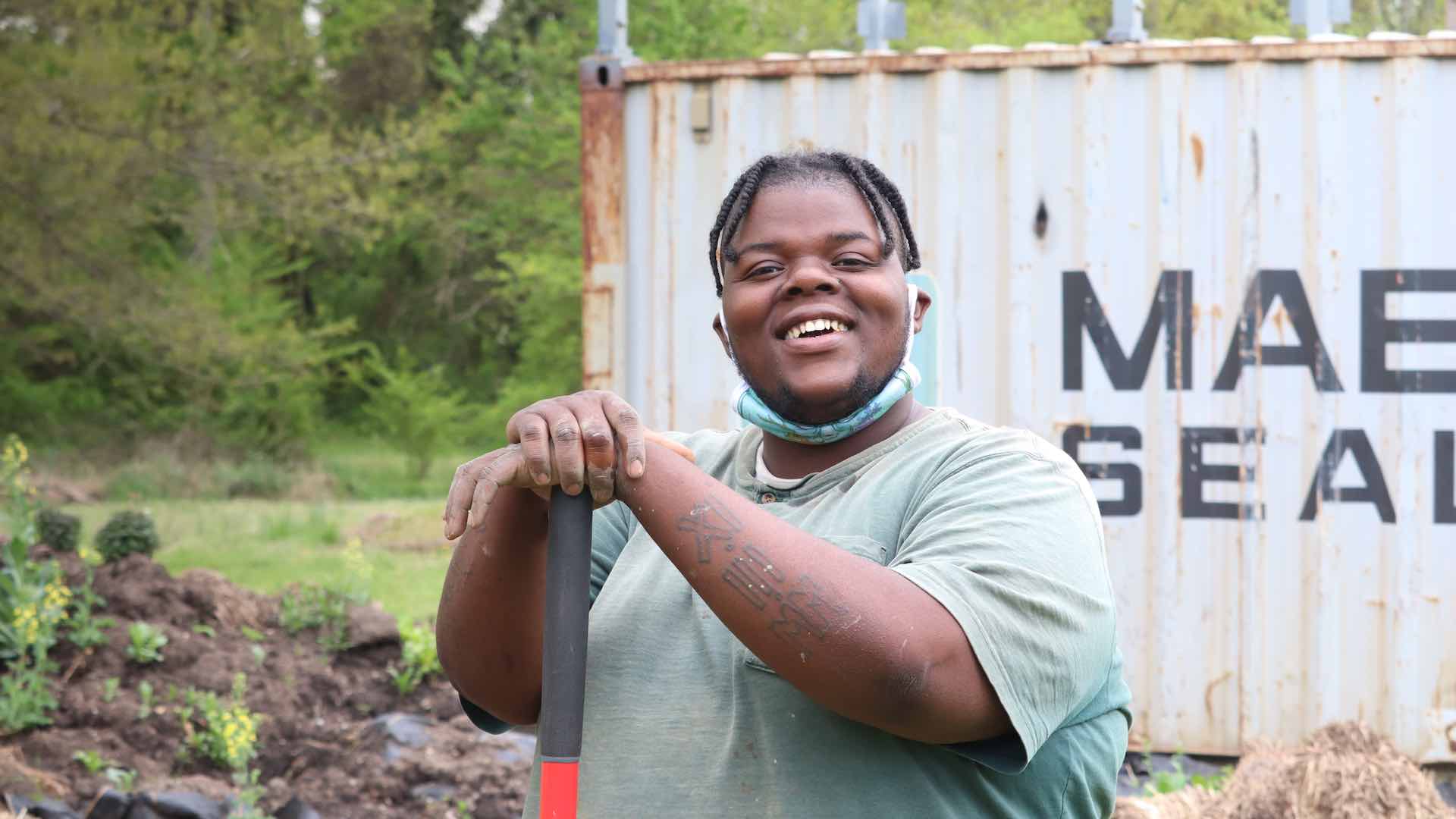| | | | | | | Presented By Capital One | | | | Axios What's Next | | By Jennifer A. Kingson, Joann Muller and Erica Pandey ·Nov 29, 2021 | | Are you lingering away from home at the place where you spent Thanksgiving? You're not alone. People are stretching out their holiday travel, and planning more working vacations this season. 📅 Join Axios' Mike Allen and Niala Boodhoo tomorrow at 12:30pm ET for a virtual event spotlighting innovations in philanthropy and charitable giving. Guests include GivingTuesday CEO Asha Curran and Cava co-founder and CEO Brett Schulman. Register here. 📷 Send a photo of something cool and forward-looking that we can publish. Email: whatsnext@axios.com. Today's Smart Brevity count: 1,280 words ... 5 minutes. | | | | | | 1 big thing: Stretching the holidays with remote work |  | | | Illustration: Sarah Grillo/Axios | | | | Some workers are extending their holiday vacations, using the time on either side of the turkey (or Yule log) to Zoom from their childhood bedrooms or a beach resort, Joann Muller writes. Why it matters: Our new predilection for taking longer holidays (to work and play) is redefining travel patterns and habits. The big picture: After skipping Thanksgiving and Christmas gatherings last year, people want to linger with friends and family this year. And flexible remote working arrangements make that easier than ever. - "Bleisure travel" — tacking a few leisure days onto a business trip — isn't new. But over the past year, that idea has flipped. Now, people are adding remote working days to their vacations.
- "The pandemic has reshaped society. And I think how Americans travel for the holidays may be one of those lasting changes," Mike Daher, Deloitte's vice chairman of U.S. transportation, hospitality and services, tells Axios.
Details: Overall, an estimated 53.4 million people traipsed through airports or sat in traffic jams over the Thanksgiving weekend, says AAA — very close to 2019 levels. What's new: There's evidence people are stretching out their holiday travel, and planning more trips before year-end. - Airbnb says bookings for long-term stays during the holidays are up nearly 70% in the U.S., compared to the same time in 2019.
- CLEAR, which runs biometric security kiosks at many airports, says the median trip length of its members has doubled in 2021 vs. 2019.
The extended holiday travel is because more people are blending travel and work. - Working vacationers plan to take twice as many trips, and to stay longer, than those who intend to disconnect for the holidays, according to a Deloitte survey.
- Three in four workers said they'll add at least one day to their holiday trips and 38% say they'll add three to six days.
- They also say they'll increase their vacation travel budget because of their company's work-from-home policies.
What they're saying: Younger, tech-savvy workers are behind the working holiday vacations, Daher explains. - "This younger generation wants a different lifestyle when it comes to work. They want to travel more, experience life, and enjoy the flexibility that older generations aren't accustomed to."
The bottom line: Younger workers might have fewer vacation days than their older colleagues, but remote work allows them to spend the holidays with their loved ones anyway. |     | | | | | | 2. More Americans are childless by choice |  | | | Illustration: Sarah Grillo/Axios | | | | More would-be parents are opting not to have children, citing anxiety about climate change and overpopulation, The New York Times reports. Why it matters: The shift could lead to major social and economic changes, as children become rarer in many parts of the U.S. and more Americans reach old age with little to no family to support them, writes Axios Future correspondent Bryan Walsh. Driving the news: A Pew survey late last week found that 44% of Americans between 18 and 49 who aren't parents say it is not too likely or not at all likely that they will have children — an increase of 7 percentage points from 2018. - Morgan Stanley analysts this summer noted that worries about climate change are "impacting fertility rates quicker than any preceding trend in the field of fertility decline."
Yes, but: Just 5% of expected non-parents in the Pew survey cited environmental reasons, a figure that is largely unchanged from earlier surveys. What they're saying: There are many other social, cultural and economic factors that influence whether people choose to bring a child into the world, Bryan notes. - Among them: declining marriage rates and ongoing struggles for work-life balance.
The bottom line: In 2020, the birthrate in the United States declined for the sixth straight year. Read Bryan's story. |     | | | | | | 3. When assisted driving tech isn't helping |  | | | Illustration: Rebecca Zisser/Axios | | | | This past weekend, for the first time, I decided to turn off my test car's assisted driving technology because it was making me feel unsafe, Joann writes. Why it matters: Potentially life-saving technologies like automatic emergency braking and lane-keeping assistance are increasingly available in today's new cars. But the technologies are only effective if they are turned on. - If drivers don't trust the technology, or find it annoying, they're likely to disable it as I did last Saturday night in the 2022 Jaguar F-Pace I was test-driving.
The big picture: We were driving home from Ann Arbor, Mich., after the Michigan Wolverines' exciting win over Ohio State. Light snow was falling, and the highway lane markings were difficult to see. - It was one of those white-knuckle drives, with traffic moving about 45 miles per hour.
- We'd already seen a number of vehicles spin off the road, and we didn't want to be next.
What happened: Several times, the F-Pace's steering wheel unexpectedly jerked to the left, causing a potentially dangerous situation. - Even with all-wheel-drive, I'd already felt the car fishtail several times on the slippery road.
- I worried that any sudden correction could cause a spinout.
I realized the car's lane-keeping system was searching for the road markings, as was I. - I decided we were safer with it turned off, so I used the control on the steering wheel to disable it.
- In dicey situations like this, there can be only one driver.
The bottom line: Once again, I was reminded of the limitations of vehicle automation. Until fully autonomous cars are here, the human driver must always be in charge. |     | | | | | | A message from Capital One | | The COVID-19 pandemic's impact on lower earners | | |  | | | | The recently published Capital One study, Marketplace Index: The Road to Recovery, paints a picture of how the pandemic affected lower earners. Key numbers: 55% of people earning less than $25,000 a year reported feeling less secure in their jobs now than they did early in the pandemic. Read more. | | | | | | 4. Santa's robot elves | Nimble Robotics' machines pick goods at an e-commerce warehouse. Credit: Nimble RoboticsAs more of our goods and gifts are being purchased online, robots are set to play a bigger role in e-commerce warehouses, Bryan writes. Why it matters: With retailers struggling to meet the demand for workers in a tight labor market, smarter robots that can adapt to the often chaotic conditions of a warehouse could help close the gap. When you place an online order this holiday season, it will need to be fulfilled by a retailer, which means that good has to be physically picked and packed at a warehouse. - It's usually been humans doing the work — as of August, nearly 150,000 more people were employed in e-commerce warehouses than before the pandemic.
Yes, but: Retailers — especially brick-and-mortar companies that are moving increasing amounts of their business to e-commerce — are having trouble finding enough workers, opening the door to automation. How it works: Nimble Robotics is using computer vision-enabled AI — and human helpers — to train robots to pick and pack a wide variety of e-commerce goods. - "We use an algorithm called imitation learning, where you use a human to remotely operate a robot to accomplish a certain task," says founder and CEO Simon Kalouche.
- "If you do this hundreds or thousands of times over various tasks, you can train a neural network to say, 'I've seen this and I know how to pick it up.'"
- Human remote operators are still available to help them through unexpected obstacles.
The bottom line: Robots won't be fully replacing human warehouse workers any time soon, but an automated e-commerce Santa Claus may not be too far off. Read the full story. |     | | | | | | 5. Reader photo of the day |  | | | Photo: Greg Cantori | | | | What's Next: Velomobiles Greg Cantori of Pasadena, Md., writes: "Having commuted, toured and raced in my human-powered vehicle called a velomobile, I'm convinced it's What's Next for many people who want a practical, fast, weatherproof and protected vehicle in addition to a bicycle." Cantori says there are as many as 20,000 velomobiles in Europe, but only a few thousand in the U.S. "I raced at the world human-powered challenge in 2019, and reached 58.2 mph on the flats with no wind." Pictured above are Cantori and a group of "Velonauts" in a charity ride. He traveled 100 miles in less than three hours, averaging nearly 34 miles an hour. [Note: Here's an article in the Baltimore Sun that Cantori sent us about his daily commute to work by velomobile.] |     | | | | | | A message from Capital One | | The initiative cooling down Richmond's hottest areas | | |  | | | | Capital One has partnered with the Arbor Day Foundation and Groundwork RVA to plant 300 new trees in Richmond's hottest, least resourced areas. Here's why: The trees are poised to ease the heat island effect disproportionately impacting historically underserved neighborhoods. Learn more. | | | | Was this email forwarded to you? Get your daily dose of What's Next magic by signing up for our free newsletter here. |  | | It'll help you deliver employee communications more effectively. | | | | | | Axios thanks our partners for supporting our newsletters. If you're interested in advertising, learn more here.
Sponsorship has no influence on editorial content. Axios, 3100 Clarendon Blvd, Suite 1300, Arlington VA 22201 | | | You received this email because you signed up for newsletters from Axios.
Change your preferences or unsubscribe here. | | | Was this email forwarded to you?
Sign up now to get Axios in your inbox. | | | | Follow Axios on social media:    | | | | | |
Post a Comment
0Comments